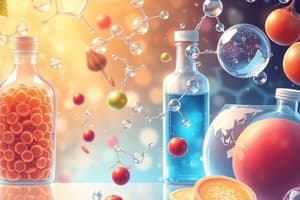Podcast
Questions and Answers
Which of the following sugars are considered reducing sugars?
Which of the following sugars are considered reducing sugars?
- Lactose (correct)
- Sucrose
- Maltose (correct)
- Starch
What is the primary function of glycogen in animals?
What is the primary function of glycogen in animals?
- Stores energy for metabolic processes (correct)
- Synthesizes proteins
- Transports nutrients
- Provides structural support in cell walls
What occurs when sucrose is heated with Fehling's solution?
What occurs when sucrose is heated with Fehling's solution?
- A blue color develops
- No precipitate is formed (correct)
- Sucrose is hydrolyzed
- A red brick precipitate forms
Which of the following polysaccharides is a polymer of glucose linked by glycosidic bonds?
Which of the following polysaccharides is a polymer of glucose linked by glycosidic bonds?
How does cellulose affect the human digestive system?
How does cellulose affect the human digestive system?
What defines a monosaccharide?
What defines a monosaccharide?
What is a key characteristic of glucose, fructose, and galactose?
What is a key characteristic of glucose, fructose, and galactose?
What type of carbohydrate is lactose classified as?
What type of carbohydrate is lactose classified as?
Which of the following statements about carbohydrates is true?
Which of the following statements about carbohydrates is true?
What is the upper limit of sugar units for oligosaccharides?
What is the upper limit of sugar units for oligosaccharides?
Which property is typical of monosaccharides?
Which property is typical of monosaccharides?
How are disaccharides formed from monosaccharides?
How are disaccharides formed from monosaccharides?
What is a common use of carbohydrates in living organisms?
What is a common use of carbohydrates in living organisms?
Study Notes
What Are Carbohydrates?
- Carbohydrates are compounds composed of carbon, hydrogen, and oxygen.
- Most carbohydrates contain six or multiples of six carbon atoms per molecule.
- These compounds contain carbonyl groups, which can be either aldehydes or ketones, and hydroxyl groups.
Role of Carbohydrates
- Carbohydrates are essential organic substances in both animals and plants.
- Carbohydrate polymers, linked to proteins and lipids, play crucial roles in organism function.
- Carbohydrates are stored as glycogen, providing short-term energy reserves.
- The oxidation of carbohydrates provides energy for the body.
Classification of Carbohydrates
- Carbohydrates are categorized based on complexity into:
- Monosaccharides: Single sugar units
- Oligosaccharides: 2-10 sugar units
- Polysaccharides: More than 10 sugar units
Monosaccharides
- Monosaccharides are the simplest carbohydrate units, and cannot be broken down further by hydrolysis.
- They are white, crystalline solids.
- All carbon atoms are linked by simple bonds.
- They are soluble in water but insoluble in organic solvents like ethanol.
- They have a sweet taste.
- They can act as reducing sugars due to the presence of a carbonyl group.
- If the carbonyl group is an aldehyde, the monosaccharide is an aldose.
- If the carbonyl group is a ketone, the monosaccharide is a ketose.
Common Monosaccharides
- Glucose (Glu): Also known as dextrose.
- Fructose (Fru): Also known as levulose.
- Galactose (Gal):
- These three monosaccharides share the same molecular formula (C6H12O6) but have different structural formulas.
Oligosaccharides
- Oligosaccharides contain 2 to 10 monosaccharide units.
- Disaccharides: Composed of two monosaccharides linked together by a glycosidic linkage.
- The formation of disaccharides involves the removal of a water molecule: Monosaccharide + Monosaccharide → Disaccharide + H2O.
Disaccharides
- Lactose: Major sugar found in milk, synthesized in the mammary gland. It is hydrolyzed into glucose and galactose.
- Sucrose: Common table sugar, produced commercially from beets and cane sugar. It is hydrolyzed into glucose and fructose.
- Maltose: Produced during starch digestion in the human body. It is hydrolyzed into two glucose molecules.
Reducing Sugars
- All monosaccharides (glucose, fructose, galactose) and some disaccharides (lactose and maltose) are reducing sugars.
- Reducing sugars react with Fehling's solution, which is a blue solution, to produce a red brick precipitate when heated.
- Sucrose does not react with Fehling's solution.
Polysaccharides
- Polysaccharides are polymers containing hundreds or thousands of monosaccharide units linked together by glycosidic linkages.
- Examples include starch, cellulose, and glycogen.
- Polysaccharides can be either linear (cellulose) or branched (glycogen).
Polysaccharides in Detail
- Starch: Composed of glucose units, found in plants like bananas and legumes.
- Glycogen: The essential storage polysaccharide in animals, referred to as animal starch. It is stored in liver and muscle cells.
- Cellulose: The structural component of plant cell walls. It cannot be hydrolyzed in the human digestive tract due to the lack of necessary enzymes. Therefore, it is not a source of nutrition for humans but aids digestive transit and peristalsis.
Iodine Test
- Starch reacts with iodine (reddish-brown solution) to produce a dark blue color.
Studying That Suits You
Use AI to generate personalized quizzes and flashcards to suit your learning preferences.
Related Documents
Description
This quiz explores the fundamental aspects of carbohydrates, including their composition, roles in biological systems, and classification into monosaccharides, oligosaccharides, and polysaccharides. Test your knowledge on how these essential compounds function in both plants and animals.




